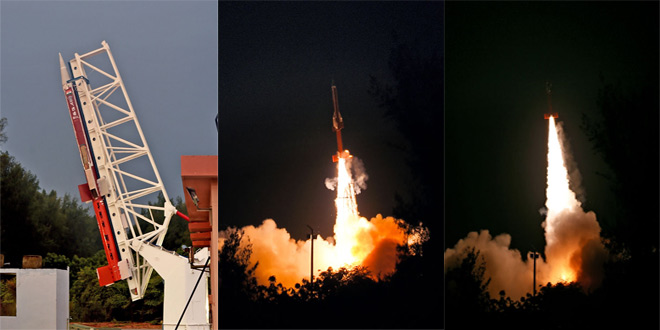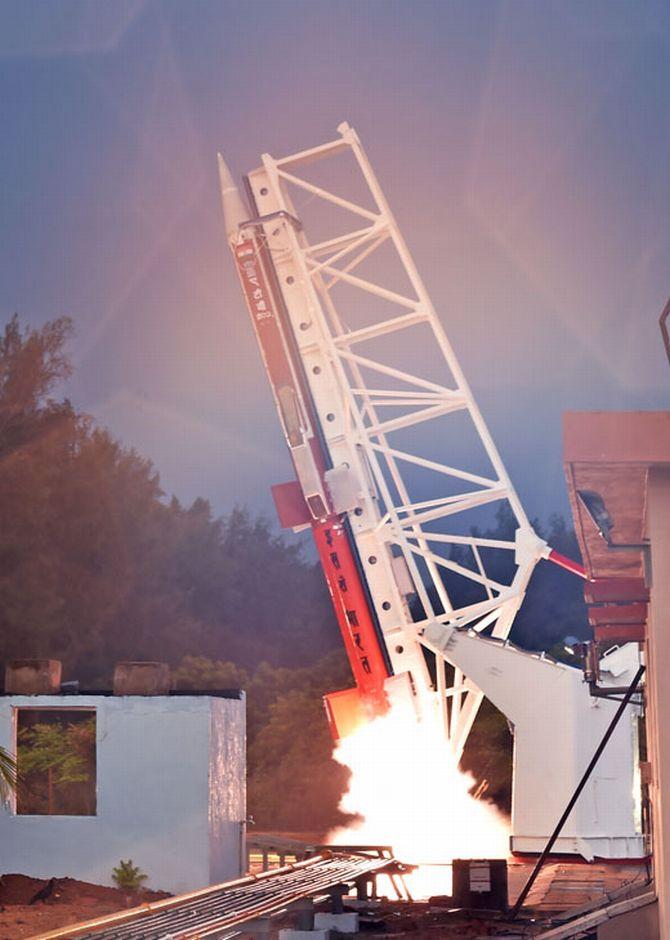India Becomes 4th Country In The World To Successful Test SCRAMJET ROCKET ENGINE - Science/Technology - Nairaland
Nairaland Forum / Science/Technology / India Becomes 4th Country In The World To Successful Test SCRAMJET ROCKET ENGINE (2075 Views)
Elon Musk Launches Car To Space on World's Most Powerful Rocket(Photos/Video) / SpaceX Rocket Explosion Destroys Facebook Satellite / Man Invents Rocket-Like Vehicle At Oke-Ado, Ibadan (Photos) (2) (3) (4)
| India Becomes 4th Country In The World To Successful Test SCRAMJET ROCKET ENGINE by Nobody: 9:47am On Aug 29, 2016 |
Scramjet – short for “supersonic combusting ramjet” – is a very high-speed propulsion system. It depends on an initial launch system, such as a solid-fuelled rocket, to propel the scramjet-powered aircraft into the air such that the scramjet’s air-breathing engine can rapidly take in the incoming air, which will pass through as exhaust during a sustained high-speed (potentially hypersonic) flight.  Indian space research organization conducted its the maiden ‘short duration experimental test’ of Scramjet engine with a hypersonic flight at Mach 6, and the ATV, an advanced sounding rocket carrying the engines, weighed 3,277 kg at lift-off. The space agency said with this flight, critical technologies have been successfully demonstrated such as 1.ignition of air breathing engines at supersonic speed, 2.holding the flame at supersonic speed, 3.air intake mechanism and 4.fuel injection systems It said Scramjet engine designed by the ISRO uses Hydrogen as fuel and the Oxygen from the atmospheric air as the oxidiser. Usually, rocket engines carry both fuel and oxidiser on board for combustion, but these newly developed engines with air-breathing propulsion system will use oxygen from the atmosphere thereby reducing the lift-off mass of the vehicle. It will also help in bring down launch costs substantially. The Scramjet engine will also be used eventually to power ISRO’s reusable launch vehicle at hypersonic speed. ATV is a two-stage spin stabilised launcher with identical solid motors (based on Rohini RH560 sounding rocket) as the first as well as the second stage (booster and sustainer), the ISRO said. The twin Scramjet engines were mounted on the back of the second stage. Once the second stage reached the desired conditions for engine ‘start-up’, necessary actions were initiated to ignite the Scramjet engines and they functioned for about five seconds, it said adding that Sunday’s ATV flight operations were based on a pre-programmed sequence. Addressing a press conference in Chennai later, Vikram Sarabhai Space Centre Director K Sivan said two sounding rockets were used -- one was tagged with another -- for the technology demonstration. While one went up to seven kilometres and descended, the other which had two scramjet engines strapped onto it went further, up to 20 kilometres. Two scramjet engines were mounted alongside of a two-stage, solid fueled rocket called Advanced Technology Vehicle (ATV), which is an advanced sounding rocket. Scramjet engines were then ignited when ATV achieved a speed of Mach 6 (7350 km/hr) at an altitude of 20 km. Scramjet engines were fired for a duration of about 6 seconds. The technology was indigenous, in tune with ‘Make in India theme of the Central government,’ he said. While the duration of scramjet engine functioning was five seconds, at the beginning of the five second duration, fuel was injected and then engine ignited automatically. “The injection of fuel lasted for seven seconds, the burning happened, flame was sustained and the result showed that what we wanted has happened.” Scramjet engines had auto-ignition capability, he said, adding ignition happens when hot air gets into contact with hydrogen. “This is one specialty of today's demonstration.” Explaining some of the highly critical aspects of the experimental mission, he said air gets into the combustion chamber at supersonic speed. At this speed, the air gets inside the chamber continuously and ignition needs to happen at such a juncture and flame should be sustained. “It is similar to lighting a match during a cyclone,” he said. as injecting and igniting fuel in a supersonic airstream is like “lighting a match in a hurricane and keeping it lit,” “Only when the flame is sustained combustion will happen,” he said, adding no other country (which has it now) would come forward to share such a complicated technology with others. Stating that auto-ignition was one aspect of technology demonstration, he said the result shows that ‘whatever we had planned was achieved, meaning we have now the (air breathing propulsion) technology’. Also the required thrust level was achieved and on Sunday ‘ISRO and India has achieved a very critical, complex technology useful for future space transportation systems either for launch vehicles or for aerospace plane’. “Now using this technology, we need to design the actual vehicle. That is the task we have cut out for us henceforth,” he said. Though a ‘baby step’, it is very ‘important step’ for future technology in this regard and the process for developing it on a full-fledged basis will take many years. Asked when the fully developed technology (air breathing propulsion) would be ready for actual application, he said, “It may take decades, definitely not in near future.” The technology could be combined with Reusable Launch Vehicle which would augment the initiative, he said.  Some of the technological challenges handled by ISRO during the development of Scramjet engine include the design and development of Hypersonic engine air intake, the supersonic combustor, development of materials withstanding very high temperatures, computational tools to simulate hypersonic flow, ensuring performance and operability of the engine across a wide range of flight speeds, proper thermal management and ground testing of the engines. The test is an important step, not only for India’s strong and increasingly prominent space program, but also the looming development of hypersonic munitions. In fact, the U.S.’s X-51A Waverider hyper-glide vehicle (HPV) utilizes a scramjet engine. It is important to understand that the value of the HPV does not purely rest in its speed (which can be attained by rockets as well), but the fact that it is an engine that is pushing the object through the sky. This imbues the aircraft with valuable capabilities such as atmospheric maneuvering (and that too at supersonic or hypersonic speeds). advantages Since majority of the mass of the rocket is oxidiser, it will in theory lead to huge savings in cost as, either Smaller rockets can be made, keeping payloads capacity the same. Larger payloads can be delivered, with same size of rocket. Scramjets also have fewer working parts than a liquid fueled rocket engine, so theoretically they could be more reliable in operation. military applications DRDO's HSTDV which is designed to be a hypersonic cruise missile which will cover 1500 km range in 600 seconds only at Mach 8
|
| Re: India Becomes 4th Country In The World To Successful Test SCRAMJET ROCKET ENGINE by DonCortino: 9:49am On Aug 29, 2016 |
Nekwanu india o! |
| Re: India Becomes 4th Country In The World To Successful Test SCRAMJET ROCKET ENGINE by OjukwuWarBird: 9:35am On Aug 30, 2016 |
Igbos can build this for Nigeria if only the cursed tribe in the South who thinks Igbps are their mates won't oppose them |
| Re: India Becomes 4th Country In The World To Successful Test SCRAMJET ROCKET ENGINE by OnposNg: 10:32am On Aug 30, 2016 |
This is impressive and to think not too long ago, India was classified as a developing country. |
(1) (Reply)
The Biggest Snake In The World Found / Get A Free, Brand New Laptop! / Here Comes The Best MTN Dataplan
(Go Up)
| Sections: politics (1) business autos (1) jobs (1) career education (1) romance computers phones travel sports fashion health religion celebs tv-movies music-radio literature webmasters programming techmarket Links: (1) (2) (3) (4) (5) (6) (7) (8) (9) (10) Nairaland - Copyright © 2005 - 2024 Oluwaseun Osewa. All rights reserved. See How To Advertise. 25 |